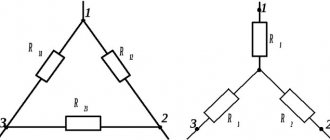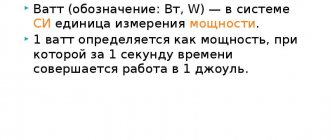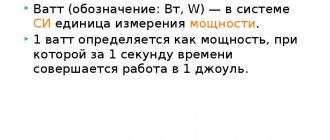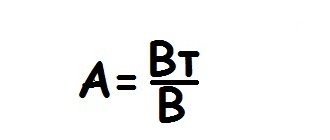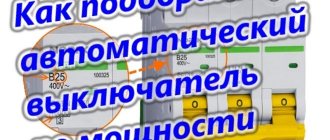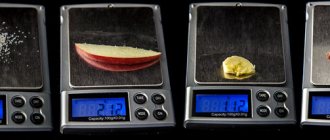Differences between "kVA" and "kW"
Sometimes on the surface of the device panel or in its description, kVA is used instead of the traditional kW for electrical power. In order for the consumer to be able to determine what value in kVA he needs, he should know that they measure the full value of the quantity, and in kW - the active value.
The total power indicator includes everything that the power source transmits externally, but it is not necessarily completely spent on doing the work. One of its fractions (active) performs work or is transformed into thermal form, the other (reactive) is redirected to the electromagnetic field available in the network. These are different quantities, although they have identical dimensions. In order not to confuse them, volt-amperes, rather than watts, are used to measure the full indicator. The pragmatic meaning of apparent power is that it describes the actual loads created by the consumer on the components of the electrical network. After all, these loads depend on how much current is consumed. Because of this, it is customary to use the volt-ampere value to indicate the power rating of switchboards and transformer devices.
When choosing a power source, it is often not clear to the consumer how much power it can actually provide. This is due to the fact that the technical parameters of such devices record the full power value in VA, and knowledge of how VA and W are related is required.
Online calculator for converting Watts to Amps to determine the load
Electrical systems often require complex analysis when designing, because you need to deal with many different quantities, watts, volts, amperes, etc.
In this case, it is precisely necessary to calculate their ratio at a certain load on the mechanism.
In some systems, the voltage is fixed, for example, in a home network, but power and current mean different concepts, although they are interchangeable quantities.
Online calculator for calculating watts to amperes
To obtain the result, be sure to indicate the voltage and power consumption.
In such cases, it is very important to have an assistant in order to accurately convert the wattage into amperes at a constant voltage value. An online calculator will help us convert amperes to watts
Before using an online program to calculate values, you need to have an idea of the meaning of the required data
An online calculator will help us convert amperes to watts. Before using an online program to calculate values, you need to have an idea of the meaning of the required data.
- Power is the rate at which energy is consumed. For example, a 100 W light bulb uses energy - 100 joules per second.
- Ampere is a measurement of electric current, determined in coulombs and shows the number of electrons that passed through a certain cross-section of a conductor in a specified time.
- The voltage of an electric current is measured in volts.
Attention: if the quantity indicator has a fractional number, then it must be entered into the system using a period, not a comma. Thus, the power calculator allows you to convert watts into amperes in a matter of time; you do not need to write out complex formulas and think about their re. sewing
Everything is simple and accessible!
sewing. Everything is simple and accessible!
Table of values Calculation table of Amperes and loads in Watts
Convert volt-amps to kilowatts online. How many kilowatts are in volt-amperes?
Round to {$ round $} {$ Plural(round, ['char', 'char', 'char']) $} after decimal point
In order to find out how many kilowatts are in volt-amperes, you need to use a simple online calculator. Enter in the left field the number of volt-amps you want to convert. In the field on the right you will see the result of the calculation. If you need to convert volt-amperes or kilowatts to other units of measurement, simply click on the appropriate link.
What is "volt-ampere"
A non-system unit of measurement of apparent power. Volt-ampere is denoted VA or V·A. In the Russian Federation, this unit is used on a par with system units. Volt-amperes are often incorrectly identified with total power, and volt-amperes and watts are spoken of as equivalent units. However, a physical quantity cannot be equated to its dimension. Two physical quantities, having the same dimension, have different meanings.
What is "kilowatt"
A kilowatt (abbreviated kW) is the decimal multiple of the International System of Units (SI) power unit watt, which is equal to 1000 W. One kilowatt is defined as the power at which 1000 joules of work are done in 1 second. The name of the unit of measurement comes from the ancient Greek chilioi - thousand and the surname of the Scottish-Irish inventor of the steam engine, James Watt (Watt). This unit of measurement is typically used to express the power output of engines and the power of electric motors, tools, electrical equipment and heaters. In addition, kilowatts are often used to express the electromagnetic output power of radio and television transmitters. A small electric heater with one heating element uses approximately 1 kW, while electric kettles range from 1 to 3 kW. One square meter of the Earth's surface typically receives about 1 kW of sunlight.
bbf.ru
Conversion table from volt-amperes to watts
Power losses when connecting a certain load are determined by the correction factor cos ϕ. With linear parameters (incandescent lamps, heating elements), the energy is almost completely used for useful work. In electric motors, reactive components degrade performance characteristics.
The cos ϕ value is indicated in the accompanying documentation:
- 0.6-0.7 – worst indicators;
- 0.8-0.9 – average;
- 1 – minimal losses.
When connecting several devices, make a table for convenience. The calculation is made taking into account the active and reactive components.
Online calculator for converting kVA to kW:
Power is a physical quantity equal to the ratio of work performed over a certain period of time to this period of time.
Power can be apparent, reactive and active:
- S – total power is measured in kVA (kiloVolt Amperes)
Characterizes the total electrical power of alternating current. To obtain the total power, the values of reactive and active powers are summed up. At the same time, the ratio of total and active power may differ for different electricity consumers. Thus, to determine the total power of consumers, their total, rather than active powers, should be summed up.
kVA characterizes the total electrical power, which has the accepted letter designation according to the SI system - S: this is the geometric sum of active and reactive power, found from the ratio: S=P/cos(ph) or S=Q/sin(ph).
- Q – reactive power is measured in kVar (kiloVar)
Reactive power consumed in electrical networks causes additional active losses (to cover which energy is consumed at power plants) and voltage losses (worsening voltage regulation conditions).
- P – active power is measured in kW (kilowatts)
This is a physical and technical quantity that characterizes useful electrical power. With an arbitrary load, an active current component acts in the alternating current circuit. This part of the total power, which is determined by the power factor and is useful (used).
The unified power factor is denoted by Cos φ.
This is the power factor, which shows the ratio of (losses) kW to kVA when connecting inductive loads.
Common power factors and their interpretation (cos φ):
1 – best value
0.95 is an excellent indicator
0.90 – satisfactory value
0.80 – average most common indicator
0.70 is a bad indicator
0.60 – very low value
kW characterizes the active consumed electrical power, which has the accepted letter designation P: this is the geometric difference between the total and reactive power, found from the relationship: P=S*cos(f).
In consumer terms: kW is net (net power), and kVA is gross (total power).
1 kW = 1.25 kVA
1 kVA = 0.8 kW
Prices for diesel power plants:
| 200 kW | 500 kW | 1200 kW | 2500 kW |
| 300 kW | 800 kW | 1500 kW | 5000 kW |
| 400 kW | 1000 kW | 2000 kW | 8000 kW |
Voltage 380 volts
Calculations for a three-phase network are carried out using a different formula. The voltage in such rooms is 380 V, it is distributed over three wires. Therefore, it is possible to install an automatic shutdown device with a lower rating at the same power consumption. The formula looks like this: P = U x I x root of 3. This way you can find out how many watts are in 1 ampere. To determine the number of kW, you need W x (0.7 x 380).
In a similar way, calculations can be carried out for a two-phase network. Its voltage is 266 V. One kilowatt will contain 3.7 A (1000/266). Accordingly, one ampere is equal to 266 watts. For a room with a two-phase network and a power consumption of 250 watts, a machine with a rating of 3.7 amperes is suitable. When choosing a device, you need to take into account the current strength, which is less in a three-phase network for the same amount of power consumption.
https://youtube.com/watch?v=7ZOXnl2rdM4
Object of measurement
To determine volt-amperes (V•A), you will need to perform the following measurements:
- First you will need to measure the current in amperes (A). This is the SI unit of I.
- Next, the voltage should be measured in SI units - volts. It will show the force required for the flow of electric current in volts (V).
- Calculate P - the amount of energy produced by current and volts together. Multiplying amperes (A) by volts (V) gives the resultant or energy.
Measuring quantities
Direct current (—) or DC is inherent in the process when it flows in one direction, for example, a flashlight with a battery uses a constant indicator. Alternating current (~) or AC refers to processes with alternating direction of electron movement, due to which it periodically changes its direction. In North America and Western Japan this occurs 60 times per second at a frequency of 60 Hz. In Russia, the EU, most of Australia, South America, Africa and Asia, the frequency is 50 Hz.
Watt's law formula
To convert these quantities, the formula of Watt's law is used:
Power (P) = Current (I) x Voltage (V), the same in units: watt = ampere x volt. To find amplifiers, use the Watt formula in reverse and divide the power by the voltage: Current (I) = Power (P) ÷ Voltage (V) I = 600 W : 120 V, then the value of I = 5A
Note! When specialists operate with large dimensions P, they use kilowatts (kW), 1 kW = 1000 W
Answers@Mail.Ru: how much is 1500 kW volt
You wrote this kilowatt, and kilovolt kV is designated, but in general it will be 1,500,000 volts.
watt = volts times amperes. you get 150,000 volt-ampere volts...
Where do you go with such knowledge and such power? He'll kill the hell out of it.
Did you yourself understand what you asked? 
A lot of. P@@danet - he'll kill the fuck!
kW is power. volt is voltage. The lower the load resistance (in ohms), the greater the current flow (in amperes) and the greater the power (in watts and kilowatts) at the same voltage.
touch.otvet.mail.ru
What is "volt-ampere"
Before looking at how to convert va to watts, you need to understand what va power is. Volt-ampere is a non-system measuring unit. In Russia, it is often used on an equal basis with the watt, a unit of the international SI system. Power VA is equal to the current indicators of current and voltage multiplied by each other. In writing, the measuring unit is usually shown as VA or VA. There are both submultiple and multiple units, for example, one megavoltampere contains a million VA. Such a unit is designated as MV·A, in professional speech it is called “emva”. A kilovolt-ampere is equal to a thousand VA. As a rule, subdivisions are not used in practice.
Important! Sometimes VA is mistakenly equated to total power or treated as a unit absolutely equivalent to a watt. This is an error associated with identifying a certain quantity and its dimension
Total electrical power is measured in volt-amperes; this unit is used to estimate power in circuits where alternating electric current operates: under these conditions there is no need to convert it into watts, since they are equal to each other. When working with direct current, things are different: the current-voltage indicator is equated to active (rather than total) power in watts, in which case some calculations will be required to determine the power characteristics.
What is the difference between kW and kVA?
Volt-ampere (VA) is a unit of apparent power of alternating current, denoted by VA or VA. The total power of alternating current is defined as the product of the effective values of the current in the circuit (in amperes) and the voltage at its terminals (in volts). Watt (watt) is a unit of power. Named after the Scottish-Irish mechanical inventor James Watt, it is designated watt or W. A watt is the power at which work equal to 1 joule is performed in 1 second. A watt as a unit of electrical (active) power is equal to the power of a constant electric current of 1 ampere at a voltage of 1 volt. When choosing a stabilizer or power plant, you should remember that kVA is the total power consumed, and kW is the active (expended in doing useful work) power. Apparent power is the sum of reactive and active power. Often different consumers have different ratios of apparent and active power. Therefore, to determine the total power of all consumers, it is necessary to add the total power of the equipment, and not the active power. Rated power
In the electrical industry, it is customary to define the power of most consumers in watts. This is the so-called active power - the power released by a purely resistive load (Heaters, TVs, light bulbs, etc.). Active power is entirely used for useful work (heating, mechanical movement), and it is usually understood as power consumption. If the consumer is active (kettle, incandescent lamp, heating element), then no other information is required about him; such consumers are written (usually ) rated power in W, rated voltage and that's it. There are no questions about the cosine “phi” here, because this “phi” (the angle between the current and voltage of these consumers) is equal to zero, the cosine of zero is 1, - hence, Active power (“P”) is equal to the product of the current through the consumer and the voltage at the consumer, multiplied by this notorious cosine “phi”, those. P = I*U*Сos (fi) = P = I*U*1 = P=I*U. A simple example for a heater with cos phi=1: Total power S=10 kVA cos phi=1 Then active power P=10*1=10 kW
For consumers that have not only active resistance, but also any reactive resistance (inductance, capacitance), it is customary to write the value “P” in Watts on the nameplate, as well as indicate the value of the cosine “phi”. The value of the cosine “phi” is determined by the parameters of these consumers themselves, or more precisely, by the ratio of their active and reactive resistances. For example, an ordinary electric motor has on the tag: P=5kW, Cos(fi)=0.8. This means the following: This engine, when operating (in nominal mode), consumes full Apparent power (the sum of active and reactive powers). Active power “S” equal to P/Cos(fi)=5/0.8= 6.25 kVA and Reactive power “Q” in the amount of U*I/Sin(fi). To find the rated current of the motor, you need its Total power “S” and divide it by the operating voltage (220), however, the current is usually indicated on the nameplate. The question may arise: why is the power indicated on generators (transformers, voltage stabilizers) in VA (volt-amperes)? How else can you indicate it? Let's assume that the power on the voltage stabilizer is 10,000 VA. This should mean that if I hook up a bunch of heating elements to a given transformer, then the power supplied by the transformer to the heating elements (in the nominal operating mode of the transformer) cannot exceed 10,000 W. Everything seems to fit. What if I want to load the voltage stabilizer with an inductor or an electric motor with Cos(fi)=0.8? (a bunch of coils)? And this stabilizer will already deliver power of 8000 W, and at Cos(fi) = 0.85 -8500 W. Then the inscription on the nameplate 10000 Va will no longer be legal. Therefore, the power of generators (transformers and voltage stabilizers) can only be determined in terms of Full Power (in our case, 1000 kVA), and how you use it (Full Power) is your business. Now you can move on to selecting a voltage stabilizer, power plant, uninterruptible power supply, inverter.
Power factor, cosine "phi"
This is the ratio of the average AC power to the product of the effective values of voltage and current. The highest value of the power factor is 1. In the case of sinusoidal alternating current, the power factor is equal to the cosine of the phase shift angle between the voltage and current sinusoids and is determined by the circuit parameters: Cos f = r/Z, where f (“phi”) is the phase shift angle, r - active resistance of the circuit, Z - total resistance of the circuit. The power factor may differ from 1 in circuits with purely active resistances if they contain nonlinear sections. In this case, the power factor decreases due to distortion of the voltage and current curves. The power factor of an electrical circuit is the cosine of the phase angle between the bases of the voltage and current curves. According to another definition, power factor is the ratio of active and apparent energy. Power factor (Cos φ = Active power/Apparent power = P/S (W/VA) consumed by the load. Power factor is a complex indicator characterizing the linear and nonlinear distortions introduced by the load into the electrical network. Typical power factor values: - 1.00 - ideal value; - 0.95 - good indicator; - 0.90 - satisfactory indicator; - 0.80 - average indicator of modern electric motors; - 0.70 - low indicator; - 0.60 - poor indicator.
Ampere – Watt conversion table
To convert watts to amperes, you need to use the previous formula, expanding it. To calculate the current, you need to divide the power by the voltage: I = P/U. The following table shows the amperage for devices with different voltages - 6, 12, 24, 220 and 380 volts.
Table of the ratio of amperes and watts, depending on voltage.
| 6V | 12V | 24V | 220V | 380V | |
| 5 W | 0.83A | 0.42A | 0.21A | 0.02A | 0.008A |
| 6 W | 1.00A | 0.5A | 0.25A | 0.03A | 0.009A |
| 7 W | 1.17A | 0.58A | 0.29A | 0.03A | 0.01A |
| 8 W | 1.33A | 0.66A | 0.33A | 0.04A | 0.01A |
| 9 W | 1.5A | 0.75A | 0.38A | 0.04A | 0.01A |
| 10 W | 1.66A | 0.84A | 0.42A | 0.05A | 0.015A |
| 20 W | 3.34A | 1.68A | 0.83A | 0.09A | 0.03A |
| 30 W | 5.00A | 2.5A | 1.25A | 0.14A | 0.045A |
| 40 W | 6.67A | 3.33A | 1.67A | 0.13A | 0.06A |
| 50 W | 8.33A | 4.17A | 2.03A | 0.23A | 0.076A |
| 60 W | 10.00A | 5.00A | 2.50A | 0.27A | 0.09A |
| 70 W | 11.67A | 5.83A | 2.92A | 0.32A | 0.1A |
| 80 W | 13.33A | 6.67A | 3.33A | 0.36A | 0.12A |
| 90 W | 15.00A | 7.50A | 3.75A | 0.41A | 0.14A |
| 100 W | 16.67A | 3.33A | 4.17A | 0.45A | 0.15A |
| 200 W | 33.33A | 16.66A | 8.33A | 0.91A | 0.3A |
| 300 W | 50.00A | 25.00A | 12.50A | 1.36A | 0.46A |
| 400 W | 66.66A | 33.33A | 16.7A | 1.82A | 0.6A |
| 500 W | 83.34A | 41.67A | 20.83A | 2.27A | 0.76A |
| 600 W | 100.00A | 50.00A | 25.00A | 2.73A | 0.91A |
| 700 W | 116.67A | 58.34A | 29.17A | 3.18A | 1.06A |
| 800 W | 133.33A | 66.68A | 33.33A | 3.64A | 1.22A |
| 900 W | 150.00A | 75.00A | 37.50A | 4.09A | 1.37A |
| 1000 W | 166.67A | 83.33A | 41.67A | 4.55A | 1.52A |
Using the table it is also easy to determine the power if the voltage and current are known. This is useful not only for calculating energy consumption, but also for choosing special equipment responsible for uninterrupted operation or preventing overheating.
How many watts are in an ampere, how to convert amperes to watts and kilowatts
Not every housewife will immediately figure out how to convert amps into watts or kilowatts, or vice versa - watts and kilowatts into amperes.
Why might this be needed? For example, the following numbers are indicated on the socket or plug: “220V 6A” - a marking that reflects the maximum permissible power of the connected load.
What does it mean? What is the maximum power of a network device that can be plugged into such an outlet or used with this plug?
To get the power value, just multiply these two numbers: 220 * 6 = 1320 watts - the maximum power for a given plug or socket. For example, an iron with steam can only be used at two, and an oil heater can only be used at half power.
What is current strength:
Converting watts to amperes
Or the case when power in watts needs to be converted into amperes. This is the problem faced, for example, by a person who decides to choose a circuit breaker for a water heater.
On the water heater it is written, for example, “2500 W” - this is the rated power at a network of 220 volts. Therefore, to get the maximum amps of the water heater, we divide the rated power by the rated voltage, and we get: 2500/220 = 11.36 amps.
So, you can choose a 16 amp machine. A 10-amp circuit breaker will clearly not be enough, and a 16-amp circuit breaker will work as soon as the current exceeds the safe value. Thus, to get amperes, you need to divide the watts by the supply volts - divide the power by the voltage I = P/U (volts in a household network 220-230).
How many amperes are in a kilowatt and how many kilowatts are in an ampere
Since there are 1000 watts in one kilowatt, then for a mains voltage of 220 volts we can assume that there are 4.54 amperes in one kilowatt, because I = P/U = 1000/220 = 4.54 amperes.
The opposite statement is also true for the network: in one ampere there are 0.22 kW, because P = I*U = 1*220 = 220 W = 0.22 kW.
For approximate calculations, it can be taken into account that with a single-phase load, the rated current I ≈ 4.5P, where P is the power consumption in kilowatts. For example, with P = 5 kW, I = 4.5 x 5 = 22.5 A.
What to do if the network is three-phase
To find the total power, multiply the line voltage, current, and multiply by √3. We have: P = 380*0.83*1.732 = 546 watts. To find amperes, it is enough to divide the power of the device in a three-phase network by the value of the line voltage and by the root of 3, that is, use the formula: I = P/(√3*U).
- Conclusion
- Knowing that the power in a single-phase network is equal to P = I*U, and the voltage in the network is 220 volts, it will not be difficult for anyone to calculate the appropriate power for a particular current value.
- Knowing the inverse formula that the current is equal to I = P/U, and the voltage in the network is 220 volts, everyone can easily find amperes for their device, knowing its rated power when operating from the network.
Calculations are carried out similarly for a three-phase network, only a coefficient of 1.732 is added (the root of three is √3). Well, a convenient rule for network single-phase devices: “there are 4.54 amperes in one kilowatt, and 220 watts or 0.22 kW in one ampere” - this is a direct consequence of the above formulas for a network voltage of 220 volts.
How to convert Amperes to Kilowatts in a three-phase network
Watt = √3 * U * I;
√3 = 1,732;
P = √3 * U * I;
Ampere = W /(√3 * V)
I = P / √3 * U
Task. Calculate the power of a three-phase water heater. When it is operating, the current clamp shows a load of 3.8 A.
P = 1.732 * 380 * 3.8 = 2501
Answer: The power of the water heater is 2.5 kW.
Note. The numbers may be completely different, depending on the heater control circuit.
Let's summarize. Using the above formulas, selecting materials for repair or installation will not be difficult, even for people who do not have an electrical engineering education.
To reinforce the information, watch a video on the topic. It is created a little old-fashioned, but useful and educational.
Also read: Calculation of the power of a three-phase network.
I will end here. Write your questions in the comments. If the article was useful, then click on the social media buttons. Until next time. Bye.
Sincerely, Semak Alexander!
Convert how many amperes a kW has online. Calculator for converting current amperes to power watts
Power in an electrical circuit represents the energy consumed by a load from a source per unit time, indicating the rate at which it is consumed. Unit of measurement Watt
.
The current strength displays the amount of energy passed over a period of time, that is, it indicates the speed of passage. Measured in amperes
. And the voltage of electric current flow (potential difference between two points) is measured in volts. Current strength is directly proportional to voltage.
To independently calculate the Ampere / Watt or W / A ratio, you need to use the well-known Ohm's law. Power is numerically equal to the product of the current flowing through the load and the voltage applied to it. Determined by one of three equalities: P = I * U = R * I² = U²/R.
Therefore, to determine the power of the energy source when the current in the network is known, you need to use the formula: W (watts) = A (amps) x I (volts).
And to make the reverse conversion, you need to convert the power in watts to the current consumption in amperes: Watt / Volt.
When we are dealing with a 3-phase network, we will also have to take into account the coefficient of 1.73 for the current strength in each phase.
How many Watts are in 1 Ampere and amperes in a cotton wool?
- To convert Watts to Amps at alternating or direct voltage you will need the formula:
- I = P/U, where
- I is the current strength in amperes; P – power in watts; U is the voltage of the volts; if the network is three-phase, then I = P/(√3xU), since it is necessary to take into account the voltage in each of the phases.
- The root of three is approximately equal to 1.73.
That is, in one watt there is 4.5 mAm (1A = 1000 mAm) at a voltage of 220 volts and 0.083 Am at 12 volts.
When it is necessary to convert current into power (find out how many watts are in 1 ampere), then use the formula:
P = I * U or P = √3 * I * U, if calculations are carried out in a 3-phase 380 V network.
This means that if we are dealing with a 12-volt automotive network, then 1 ampere is 12 Watts, and in a 220 V household electrical network, this current strength will be in an electrical appliance with a power of 220 W (0.22 kW). In industrial equipment powered by 380 Volts, as much as 657 Watts.
Differences
Active power is measured in kilowatts, and total or nominal power is measured in kilovolt amperes. Volt ampere with kilovolt ampere, being a power unit of current, is calculated as the product of current ampere values in an electrical circuit and the volt voltage at its ends. A watt per kilowatt is the energy accomplished per second and is equal to one joule. The measurement is carried out using the force of constant energy at a volt voltage.
You might be interested in: Features of a voltage divider
Note! Only a part of the device’s power is involved at the time of work activity. The rest comes out.
How do the values differ?
Converting kilowatts to amperes (single-phase 220V network)
How to convert watts to amperes:
- make a list of all consumers: 5 LED lamps of 15 W each, heater 2.3 kW, laptop 120 W;
- recalculate into a single format: 2.3 * 1000 = 2,300 W;
- sum up the obtained values: 75 2 300 120 = 2 495 W;
- calculate the total current when all consumers are connected simultaneously:
I (current) = P (power) / U (voltage) = 2,495 / 220 = 11.34 A.
Select the machine with the nearest higher nominal value. For this example, a 16 A protective device is suitable. The serial product is designed for a load power of up to 3,500 W, which more than covers the existing needs. The power supply network is made of copper (aluminum) conductors with a cross-sectional area of 1.5 (2.5) square meters. mm, respectively.
How many volts does 1 ampere contain?
As in the previous example, such questions are asked incorrectly. Converting voltage to current is possible only taking into account:
- electrical resistance of the circuit section;
- power;
- load characteristics;
- constant (variable) parameters of the power supply network.
However, it should be noted that in the Russian Federation, along with the international standard (SI), the non-system unit “Volt-ampere” is used. Its value is equal to 1 W of power, so there is no need to convert using additional coefficients. In this case we are talking about power supply with a sinusoidal signal in a single-phase network.
Volt-amp power refers to the total energy of the power source that is consumed per hour. Measure the actual voltage values at the generator terminals and the current in the connected circuit. This means that in real conditions some of the energy will be wasted on:
- thermal heating;
- electromagnetic oscillations created by reactive components.
What is tension? Volt
Voltage is a physical quantity that characterizes the ratio of the work of the electric field in the process of transferring a charge from one point A to another point B to the value of this same charge. Simply put, it is the potential difference between two points. Measured in Volts.
The voltage is essentially similar to the amount of water pressure in the pipe; the higher it is, the faster the water flows from the tap. The voltage is standardized and the same for all apartments, houses and garages, equal to 220 Volts with single-phase power supply. Also allowed according to GOST is a 10 percent deviation for the home electrical network. The voltage must be no less than 198 and no more than 242 Volts.
1 Volt contains:
- 1,000,000 microvolts
- 1,000 millivolts
How to use an online calculator
Knowing the current parameters, you can independently calculate such an important parameter as power. This value determines the rate of energy consumption per unit of time, so you can calculate additional costs and load on the network when the device is turned on.
What information will you need to enter:
- Mains voltage, which may also vary. Car wiring is usually designed for 12 V voltage. On older models, the indicator is still 6 V, and on large vehicles - 24 V (buses or trucks with diesel engines).
- Rated current, the value of which can usually be found from the technical data sheet of the equipment. Typically, such information is placed directly on the device body.
The intuitive interface of the calculator will allow you to quickly convert amperes to kilowatts and perform other similar operations. The service will allow you to quickly convert the power consumption of electrical appliances in order to calculate the load on the network. In addition, such a calculator will provide car owners with complete information about the consumed power of the electrical network. This will allow you to easily select a new battery and replace individual electrical wiring components.
How to convert watts to amperes - instructions.
The formula we need looks like this:
P=I*U
The following indicators are used here:
- P – power (W),
- I – current strength (A),
- U – network voltage (V – volts).
Regarding voltage, we note that in a household electrical network, the voltage in the most common single-phase lines is 220 V.
As in any other formula, knowing two indicators out of three, the last third indicator (“unknown”) is very easy to find. Based on the question posed at the beginning, we need to find the current strength (amps), knowing the power (watts). Therefore, the above formula will be transformed into the following form: I=P/U.
A small example is a problem about how watts are converted to amperes and why.
There is a kitchen. There is a group of sockets in the kitchen. This entire group of sockets is turned off by an automatic switch in the electrical panel, which has the designation 16A. The following appliances are connected to the sockets in the kitchen: microwave (1000 W), electric kettle (2000 W), oven (1500 W). The question is: will the line hold up if all these devices are turned on at the same time?
Solution.
Having a 16A circuit breaker, we must assume that this data will serve as the limiting value for us; the current strength in this section of the circuit should not exceed 16A. First, we add up the powers, and in total we get 4500 watts. Next, according to our formula, we obtain the current strength (amps): 4500/220 = 20.45 A. Accordingly, if you turn on the electric kettle, microwave and oven at full power, then the 16A safety circuit breaker will simply “knock out”.
Hence the conclusion: it is very useful sometimes to think about how to convert watts into amperes, and then apply the calculations in practice, especially during repairs, for example, to lay (as in our example) an additional electrical line that allows you to distribute the load along different wires, or to relay the line using other wires designed for higher current.
calculator online conversion Watts to kW
The power of electrical equipment, especially household appliances, is specified in both watts and kilowatts. The question arises, how many watts are in a kilowatt, or how to convert watts to kilowatts and back.
Power
How to convert watts to kilowatts
The power of electrical appliances is indicated by the symbol “P”, from the Latin word “potestas” - power. In some cases the symbol "N" is used. In some, the symbol “W” is used, from the English “watt”. The unit of power measurement is 1 watt or 1 kilowatt.
In the SI system, the prefix “kilo” before the name of a unit of measurement always denotes a factor of one thousand. For example, there are 1000 meters in a kilometer, 1000 grams in 1 kilogram, and 1000 watts in one kilowatt. A 500 watt heater may be listed as a 0.5kW heater, a 1500 watt heater as a 1.5kW heater, and a 2000 watt heater as a 2kW heater. It is in kilowatts that the energy consumption of industrial equipment and the power supply of residential buildings is measured.
In addition to the prefix “kilo”, the prefix “mega” is also used. It means million. There are 1,000,000 watts in a megawatt, and to find out how many kW there are, for example, in 5 megawatts, this number must be multiplied by 1000. The result is 5,000 kW. Megawatts measure the energy produced by power plants and the consumption of large industrial enterprises with energy-intensive production.
Table of conversion of some dimensions to others
How is electrical power measured?
The power of electrical equipment, according to the laws of electrical engineering, is defined as the product of the current flowing through it and the voltage. When measuring, you should take into account the dimension of the quantities, otherwise instead of 1 W you will get 1 kW or vice versa:
Wattmeter device
There are special instruments for measurement. They have two windings, one of which is connected in parallel to the load to measure voltage, the other in series to measure current.
There are two ways to connect such devices:
- Directly to the network. In this case, the device readings will correspond to the energy consumed;
- If the network parameters exceed the permissible limits of this device, then they can be expanded in the same way as for an ammeter and voltmeter separately. In this case, the measurement result should be multiplied by the degree of increase in the limits. For example, when using a 100/5 current transformer, which increases the voltage measurement limit by 20 times, and the wattmeter reading is 30 kW, the actual power will be 600 kW.
Difference between "kilowatt" and "kilowatt-hour"
Given the similarity of names, kW corresponds to the concept of “power”, and kW*h - the electricity consumed or the work performed.
For example, the power of lightning is 200,000 mW, and the total energy is 55 kWh. This amount of energy is consumed by a 100 W lamp in 550 hours or three months of burning in the living room in the evenings.
Horsepower
In addition to kilowatts, the power of automobile engines is still measured in outdated units - horsepower.
This unit of measurement appeared in 1789. According to one version, the Scottish inventor James Watt, in whose honor the unit of power “watt” got its name, was hired by a brewer. He wanted an engineer to build a steam engine that could replace the horse that drove the water pump. In order to determine the required performance, the amount of water that it was able to pump was measured.
According to legend, the brewer chose the strongest horse and forced it to work at its maximum strength. Watt built the necessary machine, and its power became the standard, despite the fact that an ordinary horse is approximately one and a half times weaker during prolonged work in real conditions.
The amount of “horsepower” is different in different countries. In Russia, “metric horsepower” is used, which is equal to 735 W, and in 1 kW – 1.36 HP.
In the USA and England, the amount of horsepower is slightly different. It is equal to 745 W.
Horsepower
Knowing how many watts are in a kilowatt and how to convert Watts to kW is necessary for correct measurements.
Video
Rate the article:
elquanta.ru
What is Current Strength. Ampere [A]
Current is the speed at which electrical charge flows through a conductor. One ampere is equal to a charge of one coulomb that passes through a conductor in one second. One coulomb represents a very large charge, so in most devices this value is measured in milliamps.
The current strength depends on the cross-section of the conductor and its length. This must be taken into account when planning structures, as well as choosing electrical appliances. Although most should not think about this, since this is the task of engineers and designers.
How many watts are in 1 ampere?
To determine the power of a circuit, the concept of voltage is also important. This is the electromotive force that moves electrons
It is measured in volts. Most devices have this characteristic in their documentation.
To determine the power at a current of one ampere, you need to know the network voltage. So, for a 220 volt outlet it will be: P = 1 * 220 = 220 W. Formula for calculation: P = I*U, where I is current and U is voltage. In a three-phase network, a correction factor must be taken into account, reflecting the percentage of operating efficiency. In most cases it is between 0.67 and 0.95.
Ampere to kilowatt ratio
It is impossible to say that these two quantities are comparable, since power is measured in kilowatts, and current is measured in amperes.
But you can still calculate it like this:
- 1 kilowatt = 4.54 amperes;
- 1 amp = 220 watts;
- 1 ampere = 0.22 kilowatts.
Knowing the quantities, you can easily convert one to another. The main thing is to learn.
Is it possible to convert watts to amperes?
Here we come to the concept of “power”. We usually use the epithet “powerful” for something that is stronger, larger, heavier. Powerful iron. Powerful car. Powerful power plant.
It turns out that power is a double characteristic. On the one hand, it determines the required amount of current to “accelerate the colossus.” On the other hand, this is something that makes a colossus a colossus - some internal property. Our current flows into it from the outside, and the power is contained within it.
Each device has its own power.
When we turn off the iron, the current will stop flowing, but its power will remain with it.
Because if you connect the SAME voltage to it again, then the same current will flow into it. And we turn on a more powerful device, and another, stronger current will flow into it.
What if you connect it to a lower voltage? Then the current will flow less strongly.
And here it is - the simplest formula for determining power:
Formula
Power is the product of current and the value of the voltage supplying it.
Voltage is measured in volts, current in amperes, and power in watts.
All units are named after scientists who studied electricity, sometimes even at the risk of their lives, so that now it is so easy and simple for us to determine the power of devices - how many watts they have and how many amperes it will run if it is connected to the network.
And this is easy, because the voltage in our network is always the same - 220 volts. And then a simple relationship emerges: power is proportional to current. This means that converting amperes to watts is simple: you just need to multiply the amperage (say, 12 amperes) that enters the device during its operation by a voltage of 220 V - and we immediately get the power of the device, that is, 2640 watts.
And a current of 1 ampere flowing through a single-light chandelier with four bulbs will immediately give us a total power of the chandelier of 220 watts, each bulb will then = 55 watts (220/4).
But this does not mean that the current determined the power. On the contrary, the total power of the device, 220 watts, TOOK exactly 1 ampere of current from the network. If you connect another exactly the same light bulb to the same network, the total power will become 275 watts. And the current will depend on how we connect the light bulb.
If in parallel with the chandelier (in another socket), then a voltage of 220 volts will fall on a new 55-watt light bulb, and the current will be calculated using the same formula as follows:
55 = 220 * I
I = 55 / 220 =0.25 A.
And together, both into the chandelier and into this light bulb a current will flow from the network 1.25 A = 1 A (chandelier) + 0.25 A (light bulb)
This can be immediately seen by the slightly increased speed of rotation of the counter wheel.
How many amperes are in a kilowatt? — Useful information for everyone
- Well, let's figure it out:
1 kW is 1000 W (I hope this is clear)
To find power (which is measured in Watts), you need to multiply Volts by Amps.
Thus, if we have 100 Volts, then it turns out:
Ampere x 100 Volts = 1000 Watts, Ampere in this case is 10.
Therefore, to get 1 kW, 10 Volts will require 100 Amps.
- To convert kilowatts to amperes, you will need another indicator, measured in volts.
If current (I) is measured in amperes (A), power (P) is measured in kilowatts (kW), then voltage (U) is measured in volts (V).
I = P/U.
The mains voltage is usually 220 V.
We substitute the values specified in the problem into the formula and find the current strength, depending on the power of the device connected to the network at a certain network voltage.
- If at a voltage of 220 volts then 1000/220=4.54 amperes, and if at 380, then 1000/380=2.63 amperes. And if you need to find out 380 volts with three-phase consumption, then we divide these 2.63 by three and get 0.876 amperes.
- The same as kilometers per hour in a kilogram
